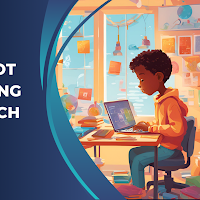
|
| Learn Robot Programming from Scratch |
Table of Contents
Introduction to Robot Programming
In today's rapidly advancing technological landscape, robot programming has emerged as a critical skill for anyone interested in robotics, automation, or artificial intelligence. Whether you're a complete beginner or someone with a budding interest in technology, understanding how to program robots from scratch can open up a world of possibilities. In this guide, we will walk you through the essential steps, tools, and strategies required to master this field.
What is Robot Programming?
Robot programming involves creating a set of instructions that guide a robot to perform specific tasks. These instructions are crafted in programming languages and executed via robotic software systems. The scope ranges from simple movements like picking up an object to complex processes such as autonomous navigation or industrial automation.
Why Should You Learn Robot Programming?
-
High-demand skill: With industries increasingly adopting automation, robot programming expertise is highly sought after.
-
Creative potential: Designing intelligent systems can be both challenging and immensely rewarding.
-
Versatile applications: From healthcare to manufacturing, robot programming finds applications in numerous fields.
Essential Tools for Beginners
Programming Languages
-
Python: Known for its simplicity and wide usage in robotics, Python is the go-to language for beginners.
-
C++: Offers more control and efficiency, making it ideal for advanced robotic applications.
-
Java: Used in Android development and some robotic frameworks.
Hardware Components
-
Microcontrollers: Arduino and Raspberry Pi are popular choices for building and controlling robots.
-
Sensors: For detecting environmental factors such as light, temperature, or proximity.
-
Actuators: These components control movement, such as motors or servos.
Software Platforms
-
Robot Operating System (ROS): A flexible framework widely used in robotics research and development.
-
Simulators: Tools like Gazebo and V-REP allow you to test robot programs in virtual environments before deployment.
Step-by-Step Guide to Learning Robot Programming
1. Start with the Basics
Begin by understanding the fundamental concepts of robotics:
-
What is a robot?
-
How do robots sense, think, and act?
-
Explore basic mechanical principles, including torque, power, and motion.
2. Choose the Right Programming Language
For beginners, Python is highly recommended due to its readability and extensive libraries, such as NumPy and OpenCV, which simplify robotic programming tasks.
3. Learn About Sensors and Actuators
Understanding how sensors collect data and how actuators execute movements is crucial. Experiment with basic components like:
-
Ultrasonic sensors for distance measurement.
-
Servo motors for controlled rotation.
4. Practice with Simulators
Robotic simulators like Gazebo provide a risk-free platform to practice your programming skills. These tools help visualize and test your robot's behavior without needing physical hardware.
5. Build Your First Robot
Start small! Assemble a basic robot using components like an Arduino board, some sensors, and motors. Write a program to make your robot perform simple tasks, such as:
-
Navigating a straight line.
-
Detecting and avoiding obstacles.
6. Dive into Advanced Topics
Once comfortable with the basics, explore more complex topics:
-
Computer Vision: Using libraries like OpenCV to enable robots to "see."
-
Artificial Intelligence: Integrate machine learning models for decision-making.
-
Autonomous Navigation: Learn about path planning and localization techniques.
Challenges You May Face and How to Overcome Them
1. Understanding Complex Algorithms
Robotics involves algorithms like A for pathfinding* or Kalman filters for state estimation. Overcome this challenge by studying one algorithm at a time and applying it in real-world scenarios.
2. Debugging Issues
Programming robots often leads to unexpected errors. Use systematic debugging methods, such as logging data or employing visualization tools.
3. Hardware Malfunctions
Hardware components can fail or behave unpredictably. Familiarize yourself with troubleshooting techniques and always have spare parts on hand.
Popular Projects for Beginners
1. Line-Following Robot
A classic project that teaches how to integrate sensors and actuators. The goal is to make your robot follow a predefined path using infrared sensors.
2. Obstacle Avoidance Robot
Learn about distance measurement and decision-making by programming a robot to avoid collisions.
3. Robotic Arm Control
Build and program a robotic arm capable of performing tasks like picking up and placing objects.
Tips for Successful Robot Programming
-
Start small: Focus on one feature or capability at a time.
-
Experiment: Test various configurations to see what works best.
-
Join Communities: Engage with forums like Robotics Stack Exchange or local robotics clubs for advice and support.
FAQs
1. What is the easiest programming language for robot programming?
Python is widely regarded as the easiest language due to its simplicity and robust ecosystem of libraries.
2. Do I need advanced math skills to learn robot programming?
While knowledge of mathematics is beneficial, you can start with basic concepts and gradually build your expertise.
3. Can I learn robot programming without any prior coding experience?
Yes, many resources cater to complete beginners, making it possible to learn robot programming from scratch.
4. What are the best resources for learning robot programming?
Online platforms like Coursera, Udemy, and YouTube offer excellent tutorials and courses.
5. How long does it take to become proficient in robot programming?
The time required varies depending on your prior experience and dedication. On average, 6-12 months of consistent practice can lead to proficiency.
Learning robot programming from scratch may seem daunting at first, but with the right approach and resources, anyone can master it. By starting with basic concepts, experimenting with small projects, and progressively tackling advanced topics, you’ll gain the skills necessary to program intelligent and efficient robots. Dive into this exciting field today and shape the future of technology.

